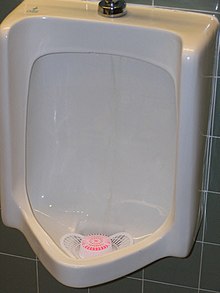Urinal deodorizer block

Urinal deodorizer blocks (also called urinal cakes, para blocks, urinal mints, urinal pucks, urinal peons (pee-ons), urinal biscuits, urinal cookies, or urinal donuts) are the small disinfectant blocks found in urinals.
The purpose of these blocks is to disinfect,[1] reduce odors or mask odors of restroom urinals. They are placed above the urinal drain (often in the confines of a small plastic trap "urinal screen" that prevents their loss down the drain when they dissolve to a small size).
Appearance and composition
Urinal deodorizer blocks are tablets (usually cylindrical in shape). The chemicals composing the block may vary. The original formulations were of naphthalene and later para-dichlorobenzene (pDCB), both now known to be hazardous to health by inhalation. In some areas, the use of para-dichlorobenzene toilet blocks has been banned; in other areas para-dichlorobenzene blocks or "para blocks" are still used. Para-dichlorobenzene and naphthalene blocks do not readily dissolve in water or urine, but do easily sublime into the air, creating a sickly-sweet odor and anti-mould and disinfectant effects.[2]
Many urinal blocks are now para-dichlorobenzene-free, water-soluble alternative blocks made from surfactants, which offer some active cleaning efficacy. The new water-soluble blocks improve the cleaning of the pipes to remove some of the cause of odor problems. Some recent formulations also include bacterial spores[3] which, coupled with the surfactant cleaning power, can more completely eradicate odors and blockages caused by the buildup of solids in the traps and pipes. Some manufacturers claim that these "biological blocks" can enable completely no-flush waterless urinals to be fitted.

Alternative toilet blocks may release pleasant odor, but also support cleaning and disinfecting of toilet bowls and urinals, in contrast to para-dichlorobenzene, which does not have cleaning properties. The block's functionality is enhanced by saturating it with a scenting compound and quaternary ammonium compounds.[1] They come in a variety of shapes and sizes, and weigh from about 20 grams up to about 100 grams when new.[3]
Autoflush[1] and/or ice are sometimes used as alternatives.[4]
See also
References
- ^ a b c "Fact Sheet on Respiratory Hazards and Restroom Deodorant Blocks". INFORM. 2009.
- ^ Rossberg, M.; Lendle, W.; Pfleiderer, G.; Tögel, A.; Dreher, E. L.; Langer, E.; Rassaerts, H.; Kleinschmidt, P.; Strack, H.; Cook, R.; Beck, U.; Lipper, K.-A.; Torkelson, T.R.; Löser, E.; Beutel, K.K.; Mann, T. (2006). "Chlorinated Hydrocarbons". Ullmann's Encyclopedia of Industrial Chemistry. doi:10.1002/14356007.a06_233.pub2. ISBN 3527306730.
- ^ a b "Green Worx Odorite data sheet" (PDF). 2012.
- ^ Upton, Chad. "Why Bars Put Ice in the Urinals". Broken Secrets. Retrieved 31 July 2013.
